The Facts of the 1967 Arab Israeli Six-Day War
March 13, 2015

MYTH
“Arab governments recognized Israel after the Suez War.”
FACT
Israel consistently expressed a desire to negotiate with its neighbors. In an address to the UN General Assembly on October 10, 1960, Foreign Minister Golda Meir challenged Arab leaders to meet with Prime Minister David Ben-Gurion to negotiate a peace settlement. Egyptian President Nasser answered on October 15, saying that Israel was trying to deceive the world, and reiterating that his country would never recognize the Jewish State.
The Arabs were equally adamant in their refusal to negotiate a separate settlement for the refugees. Nasser made clear that solving the refugee issue was not his concern. “The danger of Israel,” he said, “lies in the very existence of Israel as it is in the present and in what she represents.
Meanwhile, Syria used the Golan Heights, which tower 3,000 feet above the Galilee, to shell Israeli farms and villages. Syria’s attacks grew more frequent in 1965 and 1966, while Nasser’s rhetoric became increasingly bellicose: “We shall not enter Palestine with its soil covered in sand,” he said on March 8, 1965. “We shall enter it with its soil saturated in blood.”
Again, a few months later, Nasser expressed the Arabs’ aspiration: “. . . the full restoration of the rights of the Palestinian people. In other words, we aim at the destruction of the State of Israel. The immediate aim: perfection of Arab military might. The national aim: the eradication of Israel.”
MYTH
“Israel’s military strike in 1967 was unprovoked.”
FACT
A combination of bellicose Arab rhetoric, threatening behavior and, ultimately, an act of war left Israel no choice but preemptive action. To do this successfully, Israel needed the element of surprise. Had it waited for an Arab invasion, Israel would have been at a potentially catastrophic disadvantage.
In addition to Nasser’s verbal threats, Israel was under actual attack from Arab terrorists. In 1965, 35 raids were conducted against Israel. In 1966, the number increased to 41. In just the first four months of 1967, 37 attacks were launched.
Meanwhile, Syria’s attacks on Israeli kibbutzim from the Golan Heights provoked a retaliatory strike on April 7, 1967, during which Israeli planes shot down six Syrian MiGs. Shortly thereafter, the Soviet Union—which had been providing military and economic aid to both Syria and Egypt—gave Damascus information alleging a massive Israeli military buildup in preparation for an attack. Despite Israeli denials, Syria decided to invoke its defense treaty with Egypt.
On May 15, Israel’s Independence Day, Egyptian troops began moving into the Sinai and massing near the Israeli border. By May 18, Syrian troops were prepared for battle along the Golan Heights.
Nasser ordered the UN Emergency Force, stationed in the Sinai since 1956, to withdraw on May 16. Without bringing the matter to the attention of the General Assembly, as his predecessor had promised, Secretary-General U Thant complied with the demand. After the withdrawal of the UNEF, the Voice of the Arabs proclaimed (May 18, 1967):
As of today, there no longer exists an international emergency force to protect Israel. We shall exercise patience no more. We shall not complain any more to the UN about Israel. The sole method we shall apply against Israel is total war, which will result in the extermination of Zionist existence.
An enthusiastic echo was heard on May 20 from Syrian Defense Minister Hafez Assad:
Our forces are now entirely ready not only to repulse the aggression, but to initiate the act of liberation itself, and to explode the Zionist presence in the Arab homeland. The Syrian army, with its finger on the trigger, is united. . . . I, as a military man, believe that the time has come to enter into a battle of annihilation.
On May 22, Egypt closed the Straits of Tiran to all Israeli shipping and all ships bound for Eilat. This blockade cut off Israel’s only supply route with Asia and stopped the flow of oil from its main supplier, Iran. The following day, President Johnson declared the blockade illegal and tried, unsuccessfully, to organize an international flotilla to test it.
Nasser was fully aware of the pressure he was exerting to force Israel’s hand. The day after the blockade was set up, he said defiantly: “The Jews threaten to make war. I reply: Welcome! We are ready for war.
Nasser challenged Israel to fight almost daily. “Our basic objective will be the destruction of Israel. The Arab people want to fight,” he said on May 27. The following day, he added: “We will not accept any . . . coexistence with Israel . . . Today the issue is not the establishment of peace between the Arab states and Israel. . . . The war with Israel is in effect since 1948.
King Hussein of Jordan signed a defense pact with Egypt on May 30. Nasser then announced:
The armies of Egypt, Jordan, Syria and Lebanon are poised on the borders of Israel . . . to face the challenge, while standing behind us are the armies of Iraq, Algeria, Kuwait, Sudan and the whole Arab nation. This act will astound the world. Today they will know that the Arabs are arranged for battle, the critical hour has arrived. We have reached the stage of serious action and not declarations.
President Abdur Rahman Aref of Iraq joined in the war of words: “The existence of Israel is an error which must be rectified. This is our opportunity to wipe out the ignominy which has been with us since 1948. Our goal is clear—to wipe Israel off the map. On June 4, Iraq joined the military alliance with Egypt, Jordan and Syria.
The Arab rhetoric was matched by the mobilization of Arab forces. Approximately 250,000 troops (nearly half in Sinai), more than 2,000 tanks and 700 aircraft ringed Israel.
By this time, Israeli forces had been on alert for three weeks. The country could not remain fully mobilized indefinitely, nor could it allow its sea lane through the Gulf of Aqaba to be interdicted. Israel’s best option was to strike first. On June 5, 1967, the order was given to attack Egypt.
MYTH
“Nasser had the right to close the Straits of Tiran to Israeli shipping.”
FACT
In 1956, the United States gave Israel assurances that it recognized the Jewish State’s right of access to the Straits of Tiran. In 1957, at the UN, 17 maritime powers declared that Israel had a right to transit the Strait. Moreover, the blockade violated the Convention on the Territorial Sea and Contiguous Zone, which was adopted by the UN Conference on the Law of the Sea on April 27, 1958.
The closure of the Strait of Tiran was the casus belli in 1967. Israel’s attack was a reaction to this Egyptian first strike.
President Johnson acknowledged as much after the war (June 19, 1967):
If a single act of folly was more responsible for this explosion than any other it was the arbitrary and dangerous announced decision that the Strait of Tiran would be closed. The right of innocent maritime passage must be preserved for all nations.
MYTH
“The United States helped Israel defeat the Arabs in six days.”
FACT
The United States tried to prevent the war through negotiations, but it could not persuade Nasser or the other Arab states to cease their belligerent statements and actions. Still, right before the war, President Johnson warned: “Israelwill not be alone unless it decides to go alone. Then, when the war began, the State Department announced: “Our position is neutral in thought, word and deed.
Moreover, while the Arabs were falsely accusing the United States of airlifting supplies to Israel, Johnson imposed an arms embargo on the region (France, Israel’s other main arms supplier, also embargoed arms to Israel).
By contrast, the Soviets were supplying massive amounts of arms to the Arabs. Simultaneously, the armies ofKuwait, Algeria, Saudi Arabia and Iraq were contributing troops and arms to the Egyptian, Syrian and Jordanian fronts.
|
The Battle for Sinai
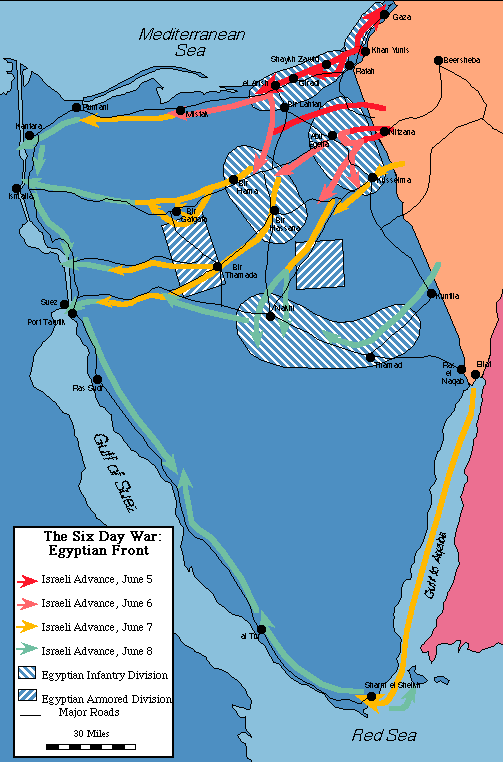 |
Battle for Jerusalem
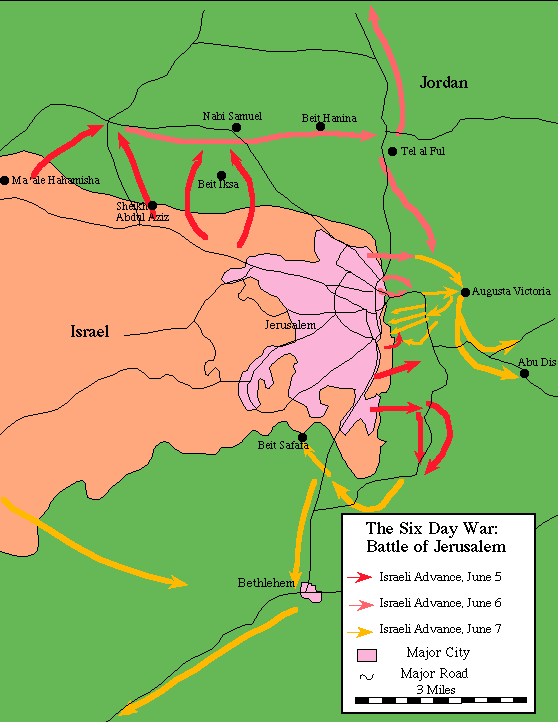 |
MYTH
“Israel attacked Jordan to capture Jerusalem.”
FACT
Prime Minister Levi Eshkol sent a message to King Hussein saying Israel would not attack Jordan unless he initiated hostilities. When Jordanian radar picked up a cluster of planes flying from Egypt to Israel, and the Egyptians convinced Hussein the planes were theirs, he then ordered the shelling of West Jerusalem. It turned out the planes were Israel’s, and were returning from destroying the Egyptian air force on the ground. Meanwhile, Syrian and Iraqi troops attacked Israel’s northern frontier.
Had Jordan not attacked, the status of Jerusalem would not have changed during the course of the war. Once the city came under fire, however, Israel needed to defend it, and, in doing so, took the opportunity to unify the city, ending Jordan’s 19-year occupation of the eastern part.
MYTH
“Israel did not have to fire the first shot in June 1967.
FACT
By using the element of surprise, Israeli forces managed to break through the enemy lines after just six days of fighting and were in a position to march on Cairo, Damascus and Amman. A cease-fire was invoked on June 10.
The victory came at a very high cost. In storming the Golan Heights, Israel suffered 115 dead—roughly the number of Americans killed during Operation Desert Storm. Altogether, Israel lost twice as many men—777 dead and 2,586 wounded—in proportion to her total population as the U.S. lost in eight years of fighting in Vietnam.19 Also, despite the incredible success of the air campaign, the Israeli Air Force lost 46 of its 200 fighters. Had Israel waited for the Arabs to strike first, as it did in 1973, and not taken preemptive action, the cost would certainly have been much higher and victory could not have been assured.
MYTH
“Israel expelled peaceful Arab villagers from the West Bank and prevented them from returning after the war.”
FACT
After Jordan launched its attack on June 5, approximately 325,000 Palestinians living in the West Bank fled. These were Jordanian citizens who moved from one part of what they considered their country to another, primarily to avoid being caught in the cross fire of a war.
A Palestinian refugee who was an administrator in a UNRWA camp in Jericho said Arab politicians had spread rumors in the camp. “They said all the young people would be killed. People heard on the radio that this is not the end, only the beginning, so they think maybe it will be a long war and they want to be in Jordan.
Some Palestinians who left preferred to live in an Arab state rather than under Israeli military rule. Members of various PLO factions fled to avoid capture by the Israelis. Nils-Göran Gussing, the person appointed by the UNSecretary-General to investigate the situation, found that many Arabs also feared they would no longer be able to receive money from family members working abroad.
Israeli forces ordered a handful of Palestinians to move for “strategic and security reasons.” In some cases, they were allowed to return in a few days, in others, Israel offered to help them resettle elsewhere.
Israel now ruled more than three-quarters of a million Palestinians—most of whom were hostile to the government. Nevertheless, more than 9,000 Palestinian families were reunited in 1967. Ultimately, more than 60,000 Palestinians were allowed to return.
After the Six-Day War ended, President Johnson announced his view of what was required next to end the conflict:“Certainly, troops must be withdrawn; but there must also be recognized rights of national life, progress in solving the refugee problem, freedom of innocent maritime passage, limitation of the arms race and respect for political independence and territorial integrity.” 26
MYTH
“During the 1967 War, Israel deliberately attacked the USS Liberty.”
FACT
The Israeli attack on the USS Liberty was a grievous error, largely attributable to the fact that it occurred in the midst of the confusion of a full-scale war in 1967. Ten official United States investigations and three official Israeli inquiries have all conclusively established the attack was a tragic mistake.
On June 8, 1967, the fourth day of the Six-Day War, the Israeli high command received reports that Israeli troops in El Arish were being fired upon from the sea, presumably by an Egyptian vessel, as they had a day before. The United States had announced that it had no naval forces within hundreds of miles of the battle front on the floor of the United Nations a few days earlier; however, the USS Liberty, an American intelligence ship under the dual control of the Defense Intelligence Agency/Central Intelligence Agency and the Sixth Fleet, was assigned to monitor the fighting. As a result of a series of United States communication failures, whereby messages directing the ship not to approach within 100 miles were not received by the Liberty, the ship sailed to within 14 miles off the Sinai coast. The Israelis mistakenly thought this was the ship shelling its soldiers and war planes and torpedo boats attacked, killing 34 members of the Liberty’s crew and wounding 171. Ships from the Sixth Fleet were directed to launch four attack aircraft with fighter cover to defend the Liberty, but the planes were recalled after a message was received at the White House that the Israelis had admitted they had attacked the ship.
Tapes of the radio transmissions made prior, during and after the attack do not contain any statement suggesting the pilots saw a U.S. flag before the attack on the ship. During the raid, a pilot specifically says, “there is no flag on her!” The recordings also indicate that once the pilots became concerned about the identity of the ship, by virtue of reading its hull number, they terminated the attack and they were given an order to leave the area.
A CIA report on the incident issued June 13, 1967, found that an overzealous pilot could mistake the Liberty for an Egyptian ship. In 1981, the National Security Agency concluded: “While these [signal intelligence of Israeli communications] reports revealed some confusion on the part of the pilots concerning the nationality of the ship, they tended to rule out any thesis that the Israeli Navy and Air Force deliberately attacked a ship they knew to be American.
Initially, the Israelis were terrified that they had attacked a Soviet ship and might have provoked the Soviets to join the fighting. Once the Israelis were sure what had happened, they reported the incident to the U.S. Embassy in Tel Aviv and offered to provide a helicopter for the Americans to fly out to the ship and to supply any help they required to evacuate the injured and salvage the ship. The offer was accepted and a U.S. naval attaché was flown to the Liberty.
In October 2003, the first Israeli pilot to reach the ship broke his 36-year silence on the attack. Brig.-Gen. Yiftah Spector said he had been told an Egyptian ship was off the Gaza coast. “This ship positively did not have any symbol or flag that I could see. What I was concerned with was that it was not one of ours. I looked for the symbol of our navy, which was a large white cross on its deck. This was not there, so it wasn’t one of ours.” The Jerusalem Post obtained a recording of Spector’s radio transmission in which he said, “I can’t identify it, but in any case it’s a military ship.
Secretary of Defense Robert McNamara told Congress on July 26, 1967: “It was the conclusion of the investigatory body, headed by an admiral of the Navy in whom we have great confidence, that the attack was not intentional.” Twenty years later, he repeated his belief that the attack was a mistake, telling a caller on the “Larry King Show” that he had seen nothing in the 20 years since to change his mind that there had been no “cover-up.
In January 2004, the State Department held a conference on the Liberty incident and also released new documents, including CIA memos dated June 13 and June 21, 1967, which say that Israel did not know it was striking an American vessel. The historian for the National Security Agency, David Hatch, said the available evidence “strongly suggested” Israel did not know it was attacking a U.S. ship. Two former U.S. officials, Ernest Castle, the United States Naval Attaché at the U.S. Embassy in Tel Aviv in June 1967, who received the first report of the attack from Israel, and John Hadden, then CIA Chief of Station in Tel Aviv, also agreed with the assessment that the attack on the Liberty was a mistake.
Israel apologized for the tragedy and paid nearly $13 million in humanitarian reparations to the United States and to the families of the victims in amounts established by the U.S. State Department. The matter was officially closed between the two governments by an exchange of diplomatic notes on December 17, 1987.
Many of the survivors of the Liberty remain bitter, and are convinced the attack was deliberate. None of Israel’s accusers, however, can explain why Israel would deliberately attack an American ship at a time when the United States was Israel’s only friend and supporter in the world. Confusion in a long line of communications, which occurred in a tense atmosphere on both the American and Israeli sides is a more probable explanation.
“The Arabs say they want their territory back, but they don’t want to talk to us, and they don’t want to negotiate with us, and they don’t want to recognize us. They want peace by immaculate conception.” Abba Eban 33

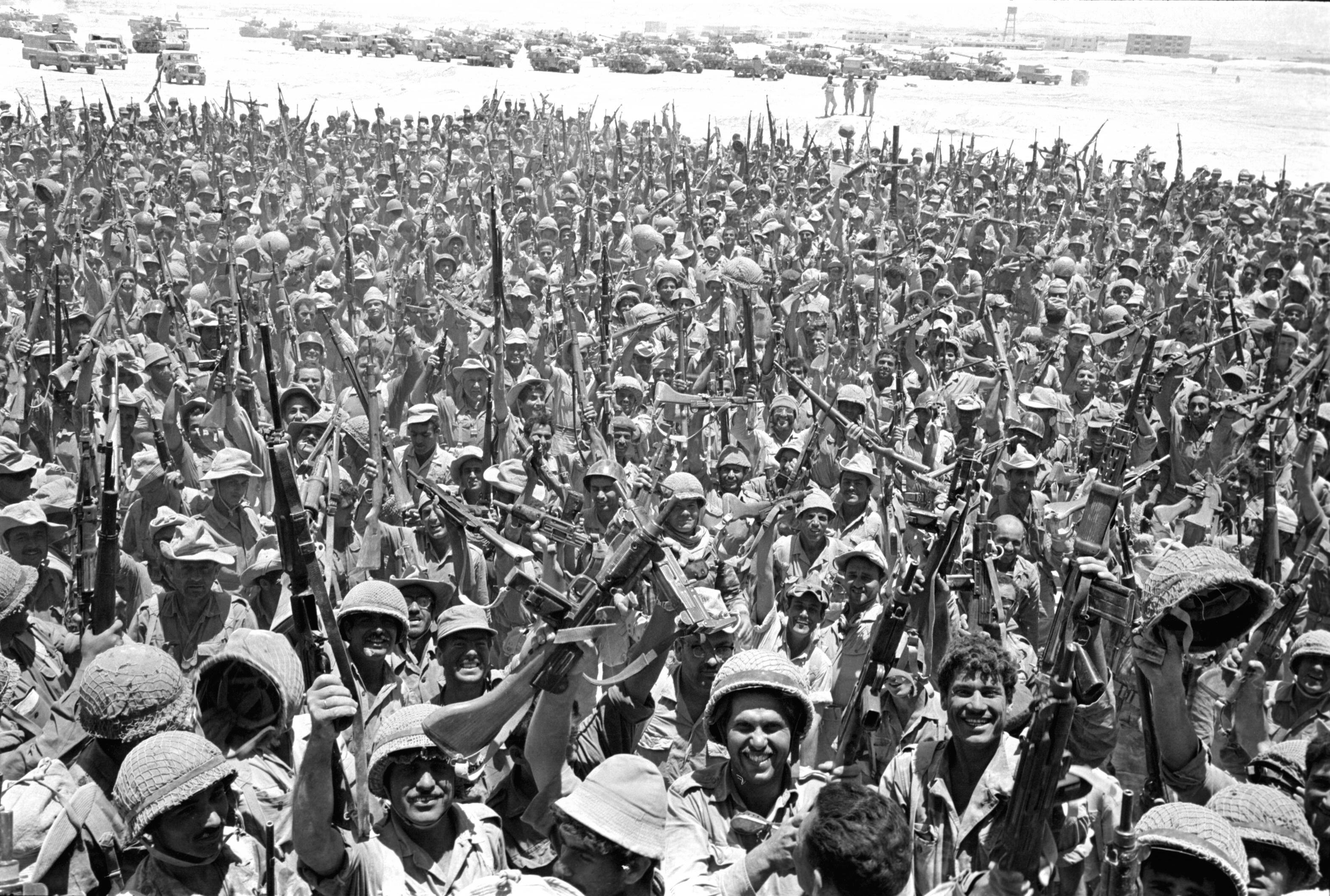
Similar posts
-

Israel Has The Most Moral Military In The World
April 10, 2024In the heart of a region often riddled with conflict, Israel stands out not only for its technologi...
-

The Resilience of the Israeli People
April 2, 2024Visitors from around the world have seen Hamas's October 7th Massacre's destruction in southern Isr...
-
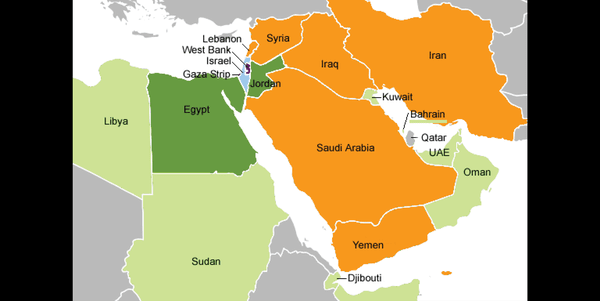
Israel: Small Size, Big Impact
March 21, 2024Nestled along the eastern edge of the Mediterranean Sea, Israel is a land of immense historical sig...
-

Israelis Are Fighting For Their Lives
February 21, 2024By Jonathan S. Tobin The world looks a lot different from Kibbutz Kfar Aza than it does in the U...
-

Over 2 Million Arabs Live In Israel
January 23, 2024In the complex landscape of the Middle East, where diverse cultures and identities intersect, Israe...
-

'Fauda' Star Idan Amedi Injured Fighting in Gaza
January 8, 2024Despite the severity of his injuries, Amedi's father assured Israeli news channels that his life is...
-

Israel Is A Great Country To Live In
December 28, 2023Nestled at the crossroads of the Middle East, Israel stands as a vibrant and dynamic nation, offeri...
-

Dear World: I Don't Care
November 2, 2023By Avi Lewis I don’t care that you sympathize with Hamas I know you wouldn’t tolerate any of ...



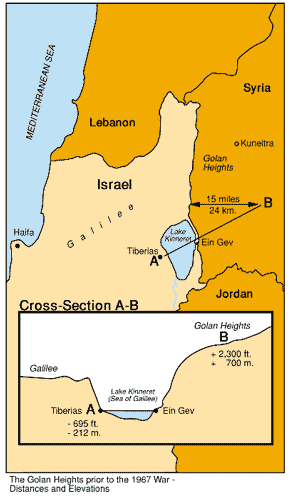
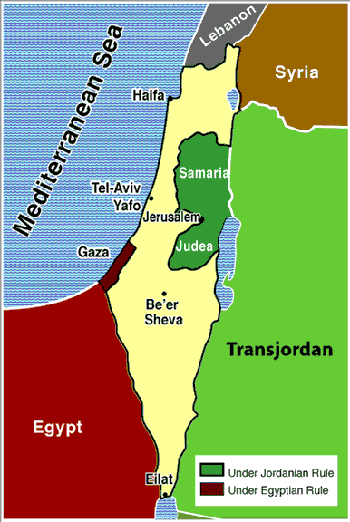


















Did not know a lot of these things. Interesting article.